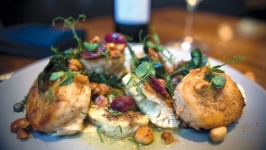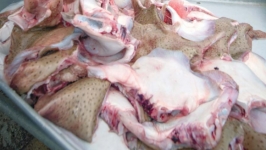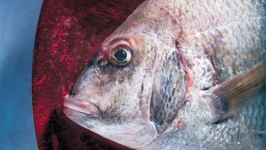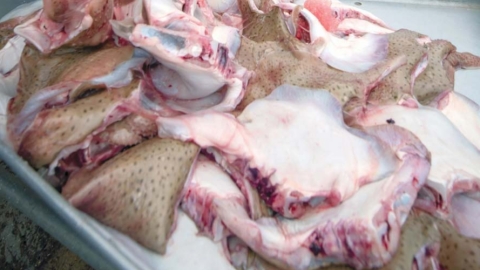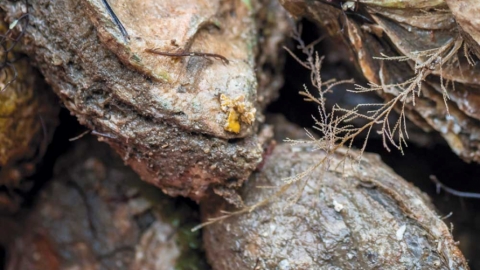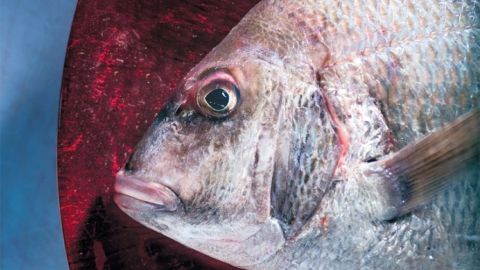From Sea to Plate - Life on a New Jersey Fishing Boat
The Atlantic is a study in gray, steel clouds meeting mineral-hued waters at the horizon. Guiding his fishing boat through the Manasquan Inlet, Jamie Dopkin veers right. Along the jetties that shape the channel, a fluorescent buoy pops like an exclamation mark, marking a scuba diver.
At sea, buoys and their colors are a form of language.
A cross between a Chesapeake Deadrise– and Down East–style boat—workhorses of the East Coast fishing trade—the FV Webo, circa 1981, is just roomy enough for Dopkin and his two passengers (and writer and photographer tagalongs). Its center is occupied by an enormous drum, which looks like a thread spool for a giant but pulls nets where targeted species run.
Dopkin leads the “crew,” just home after three weeks offshore working his main gig on an oil tug. There’s Eric Morris, founder and CEO of Local 130 Seafood, who looks in his element clad in seaweed-green Grundéns waders. And there’s restaurateur Chris Cannon of Jockey Hollow Bar & Kitchen in Morristown and daPesca, the restaurant upstairs, which celebrates local waters in exquisite fashion.
The men quickly fall into a steady banter that marks such journeys the world over, trading barbs and sharing stories.
During childhood summers in Greece, Cannon recounts, fishing was a daily event. “We had this guy that built our house, and he was a fisherman before that,” he begins, painting a scene populated by mackerel and jack mackerel. “He used to come stay at our house and brought his fishing boat with him. It was a little teeny boat, wooden, and we would just use hooks with feathers.”
Cannon erupts in his trademark laugh, quick and cerebral. “He would stand at the front of the boat, his nephew at the back, and he would just look at the surface and go: ‘Turn right. Turn left. Two hundred yards. Stop.’ He’d turn the engine off, go down and catch tons of fish. I guess he was looking at the currents. To us, it was magic.”
Though Morris and Cannon are recreational fishermen, their love for the sea is best translated on land. Yet, all three men have interest in this day’s catch. It is peak skate season, and wise to strike while they’re running hot.
In 2018, Dopkin and his business partner pulled in 120,000 pounds of skate wings. They’d like to hit 200,000 this year. Success rests in the hands of Mother Nature and the crew’s insight. Like Cannon’s Grecian fishing guide, they observe. They also augment their instincts with tech, from GPS chart plotters to thermal fish finders. “When we were kids, you had a Walkman. Today, you have a smartphone,” Dopkin says.
Known for their flat shape and fan-like pectoral fins, those “wings,” skates date back 150 million years. Their Jurassic lineage is unsurprising up close, dots or lines decorating sand-colored skin, spikes like cat claws serving warning to those who handle them recklessly. Firm and mild with whisper-sweet flavor, those wings are coveted by chefs who understand their potential.
“Skate is my favorite dish on our whole menu,” Cannon reveals. Its beauty begins here.
“It’s a six-week shot now, and maybe an eight-to-ten week shot in the fall,” Dopkin says of skate’s prime season, the chug of the boat’s single-engine echoing choppy surf. They come through like a wave. And when they do, as with monkfish, fluke, tilefish and yellow-fin, attentive eaters can savor a catch that proves transcendent in the right hands.
Still, retail consumers are confounded by the fish, with skin on both sides. “It might not sound like a big deal, but it baffles people,” Dopkin says. He pauses and laughs. The solution, as in most things, is simple: “You skin one side, and you flip it over and skin the other.”
“The whole idea of buying fish is that you know what it is. You know where it’s coming from. These guys have credibility. They’re doing the right thing.” —Chris Cannon, restaurateur
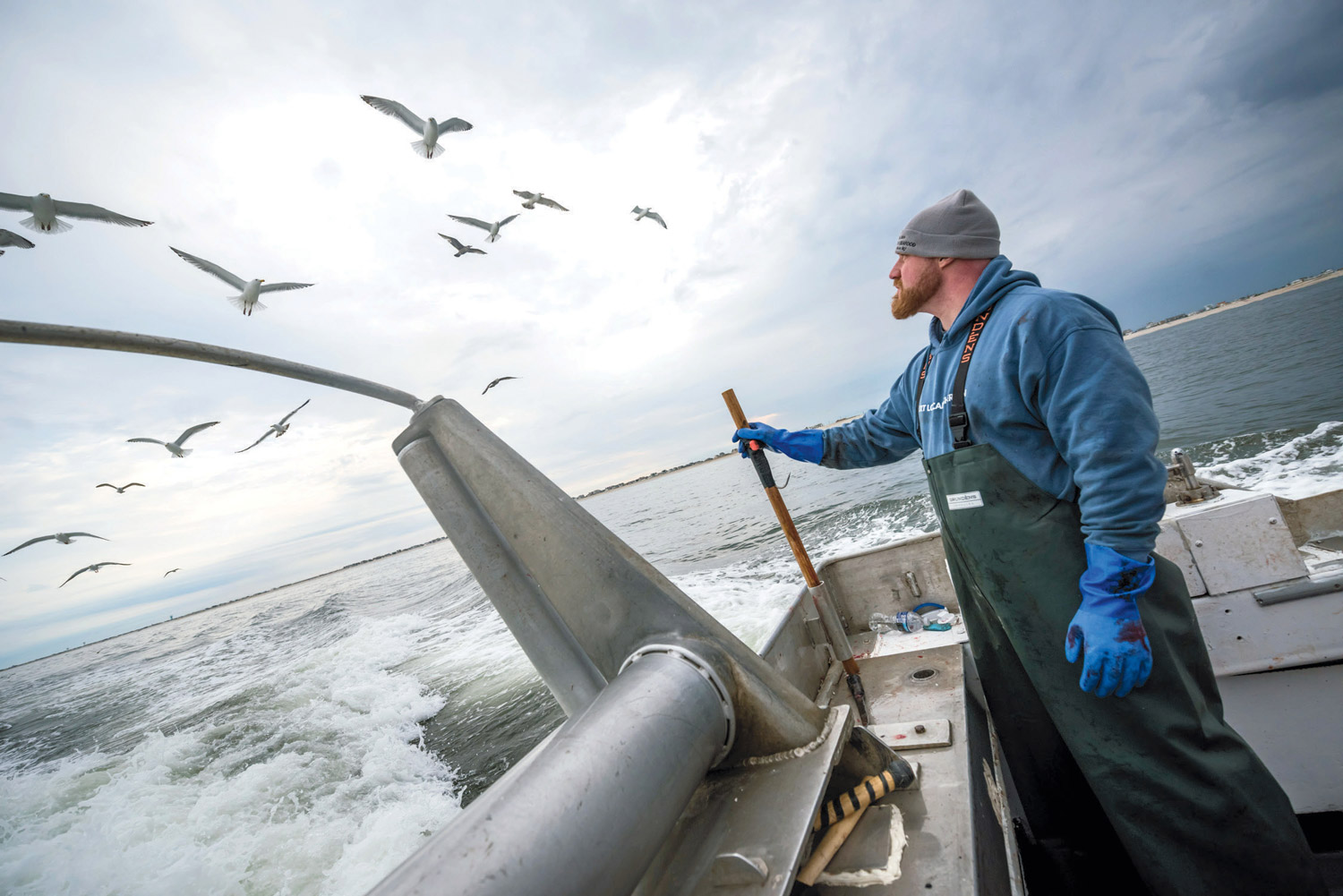
“People don’t think about New Jersey as having this really amazing seafood culture. They think of Maryland. They think of Boston. They think of Maine. What’s between Maryland and Boston? We have a really good fishing culture and community. It’s the most underrated billion-dollar industry in the state.” —Eric Morris, Local 130
The FV Webo is a 10-month-a-year side hustle that may become Dopkin’s main gig, should the waters and market cooperate. Play your cards right, and there’s money in monkfish, dogfish and skate, without the commitment of multi-day scalloping trips. For the father of two young sons, that’s key. Over the years, he’s been a scalloper and a commercial fisherman. Working the tugs, he leaves terra firma for three weeks at a clip.
“The boat will fish, will grind out a decent living and you’re home every night,” he says, perched in the captain’s seat. You won’t get rich, but you gain that back in time.
“I got into this for my kids. There are not many things that will teach you to get up every day and work as hard as you can. You can have the absolute worst day and think you’re going to be a total failure, but tomorrow you have no choice but to wake up and try again.”
It’s an old-fashioned lesson for a digital world: Dopkin would rather pull crab pots with sons Jamison and Lukas, 5 and 3, than watch them get lost in pixels. So in September 2017, he and business partner Andrew Cohaoan bought the boat from the Eble family, for whom both had worked. “Taking my two-and-a-half-year-old crabbing turned into this,” Dopkin laughs.
In turn, this led him to Morris. Local 130 Seafood is named for the state’s 130 miles of coastline and partners with day boats and fishing cooperatives to bring fresh fish to the Jersey market.
Bucking a commodity paradigm, Morris envisions a fairer, more localized approach that can translate to stabilized (and often higher) prices at the dock. “I don’t pretend to be a fisherman. I advocate for them,” Morris says. “What I’m good at is getting fish to a restaurant like Chris’ as fast as possible at the best quality possible.”
That’s a key distinction in a trade with a complicated, often opaque supply chain. Roughly $6 billion of US seafood was exported in 2017, according to the National Oceanic and Atmospheric Association. In turn, more than 90% of the seafood consumed stateside is imported, though some of that includes US-caught fish processed overseas and then sent back to us. (It’s a strange business.) Offering door-to-door service, Local 130 makes it easier for folks like Cannon to source pristine product. It also helps Cannon’s culinary team, led by Ryland Inn alum Craig Polignano, get creative.
“Do you ever get cod and tuna roe?” Cannon asks Morris.
“To make your own bottarga?” Morris asks. “Yeah, I’ll hook that up.”
Cannon smiles. “We made shad-roe bottarga. It’s curing right now. Tuna roe would be great.”
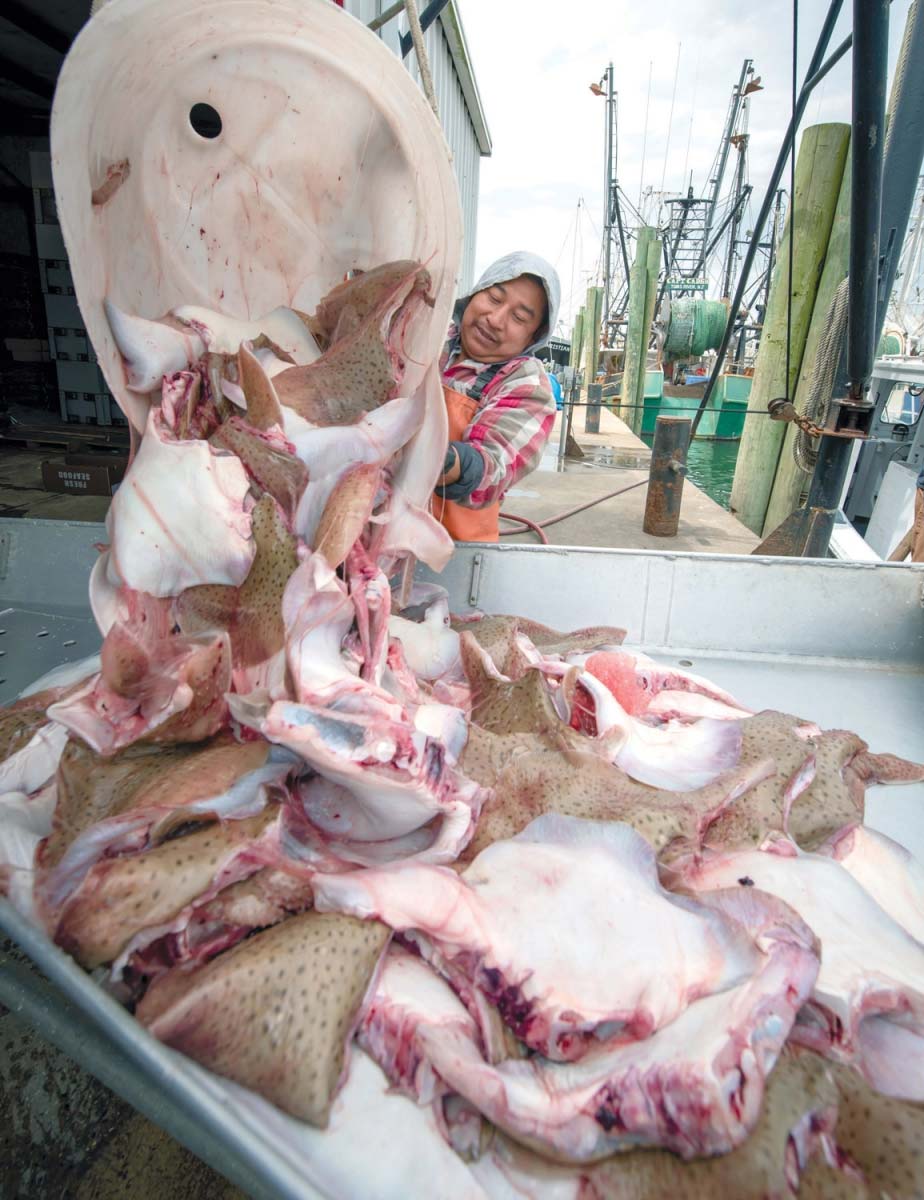
Armando Herrera unloads skate at Fisherman’s Dock in Point Pleasant Beach.
Cannon has been supporting Local 130 since it started in 2014. “He was going to come down [from Boston] and start his business and I was going to open my business, and we got together. It was kind of this natural symbiosis,” Cannon recounts. He signed on as a founding customer back when Local 130 was operating out of Morris’ parents’ Tenafly basement.
“He likes local food,” Morris says, gesturing toward Cannon.
“Fish!” Cannon exclaims. “The most important thing about the fish is that it’s fresh. There is so much fake fish all over the place. The whole idea of buying fish is that you know what it is. You know where it’s coming from. These guys have credibility. They’re doing the right thing.”
As the men talk, the Webo anchors at the fishing grounds. Everything about the operation is exacting, Dopkin says. Near the bottom, the net opens like a bag, minimizing unwanted bycatch.
“You’re looking to dial it in and be efficient. Nobody wants to go out and catch the last scallop or the last skate or the last tuna fish. Then we’re out of business.” Strict regulations also help—and there’s a joke in there, Dopkin says. “Me and my partner both work on tugs and barges moving oil. We bought a commercial fishing boat. The next thing we’ve got to get into is commercial air traffic, because they’re the three in a row that are the most regulated.” With a groan, the giant’s spool turns, and the men cluster at the bow.
“The anticipation that you have, wondering what’s in the net? I still have it. It’s the coolest part of this,” Dopkin says. As if on cue, the skate appear. Their underbellies are lunar-pale counterpoints to their sandy tops, long tails jutting from their backs. The fish are pulled up and processed at sea, one guy picking, one harvesting wings. It’s exacting, rhythmic work.
Today, Morris jumps in as deckhand, summoning skills from his former job as fishmonger at New York’s Wild Edibles Seafood and Red’s Best at the Boston Fish Pier.
“Our fishery in Point Pleasant could die,” Morris says of his inspiration. Boats are coming on the market with few young buyers coming up. “We have a lot of 50- to 65-year-old men who are fishing, and there’s not people behind them. Supporting people who are optimistic, a younger generation, is really what we want to do.”
Like Morris, Dopkin has a fundamental belief in the species coming out of New Jersey and sees potential in skate akin to the scallop boom several decades ago. “If you go to a seafood restaurant and don’t see a scallop on the menu, you’re like, ‘What is this place doing?’ Skate wings are going to be that.” While he doesn’t know whether there will be one boat or 20 when his sons take the reins—should they desire—he’s intent on cultivating memories.
“Years ago, my father said: ‘I’m not going to be rich and famous. You’re not going to inherit millions from me. The only thing you’re going to have left to live by is your memories.’” Dopkin pauses. “I’m not looking to hand my kids a billion-dollar fortune. I’m looking to give them a chance to do something that they can enjoy.”
Sometimes, he says, he’ll hear Jamison and Lukas talk about catching monkfish while playing with their action figures. Perhaps his plan is already working.






